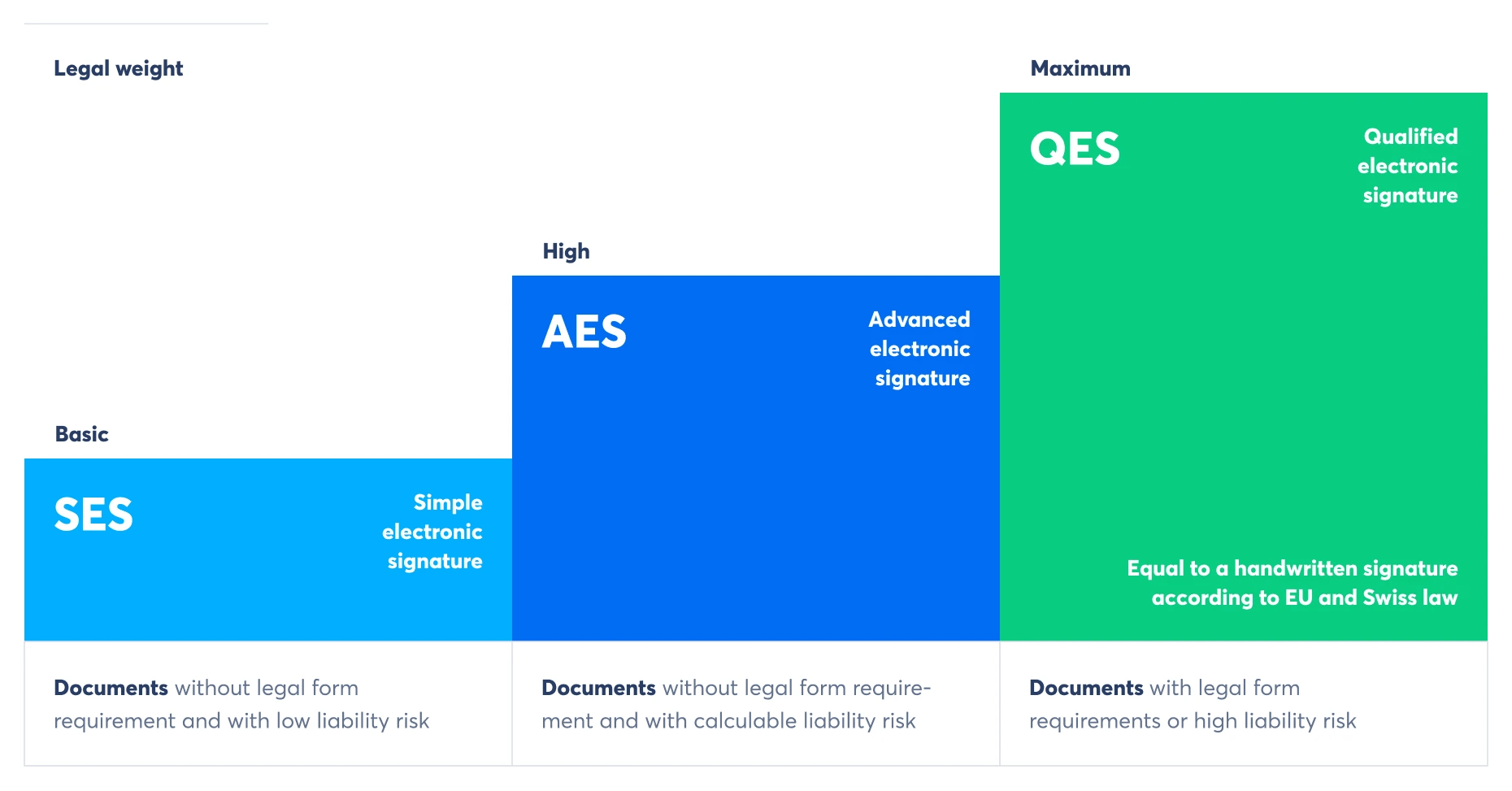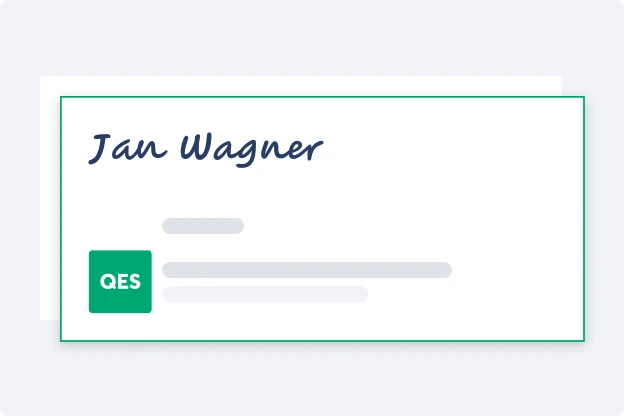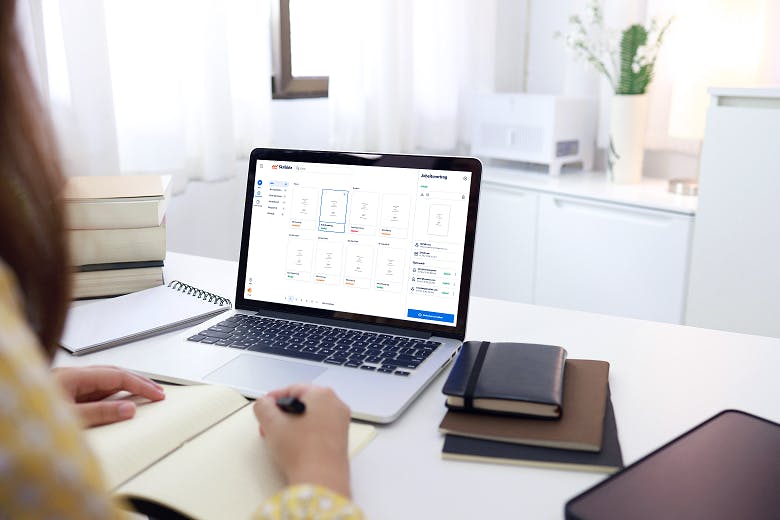Would you like to try out e-signing right away?
Qualified electronic signature (QES)

The qualified electronic signature (QES) is the highest level of three e-signature standards in Switzerland, and therefore the most secure form of electronic signature. In this article, you will learn all you need to know about QES: What exactly is it? When do I need QES in Switzerland, and how can I sign with it?
The key points in brief
- The qualified electronic signature (QES) is a special form of digital signature that can replace any handwritten signature.
- The security of QES is not based on the appearance of the signature, but on a data link in the background.
- To create a qualified electronic signature, you need the services of an e-signature provider, who supplies the necessary technical infrastructure.
- QES is legally valid for almost all documents: both informal documents and those that require written form (German: Schriftform).
- QES carries a maximum of evidential weight in the event of legal proceedings.
- The qualified electronic signature is always required when the written form is required or when a document is associated with high liability risks.
What is a qualified electronic signature?
A qualified electronic signature (QES) is a regulated electronic signature that is confirmed by a qualified certificate. It is a specific type of e-signature that meets the most stringent security and compliance requirements. QES is the highest available e-signature standard in the world, with maximum legal weight, and is recognised by all courts in Switzerland.
The European Union’s eIDAS regulation and the Swiss Federal Act on Electronic Signatures (ZertES) therefore define the QES as the only form of electronic signature that is equal to a handwritten signature before the law.
This means that whenever the written form – meaning a handwritten signature – is legally required for a contract or document, it can be replaced by QES. Of course, to protect against potential risks, QES can also be used for any other contract which requires the highest level of signature security . Companies in highly regulated environments may choose to use QES as their standard signature for compliance reasons.
QES is one of three different e-signature standards in Switzerland. The others are:
- the simple electronic signature (SES): This e-signature standard is easy to handle and has comparably the lowest evidential weight.
- the advanced electronic signature (AES): This standard has a higher evidential weight because it can be uniquely associated with the signer, enabling them to be identified. In addition, AES is linked to the data it refers to in such a way that the data cannot be modified subsequently.

Qualified electronic signature: eIDAS and ZertES
Although the Swiss ZertES and the European eIDAS regulation have many similarities, there are also significant differences between the two regulations. As Switzerland is not a member of the EU or the EEA, different certification rules apply to the recognition of electronic signatures between the two legal areas. Digital certificates issued under Swiss law are not automatically compliant with eIDAS and vice versa.
This can be challenging for European companies operating in Switzerland. It is crucial for them to select a certification service provider that is compliant with both eIDAS and ZertES to avoid legal issues. Thanks to our partnership with Swisscom AG, you can easily sign legally valid documents according to both ZertES and eIDAS with Skribble.
Would you like to try out e-signing right away?

When must the QES be used?
When combined with a qualified time stamp, qualified electronic signatures have the same legal effect as a handwritten signature according to Article 14, paragraph 2 of the Swiss Code of Obligations (OR, SR 220). They are specifically required for electronic legal transactions that are legally required to be in simple written form. The need for a qualified e-signature is indicated by phrases such as «in writing», «in written form», or «must be signed».
What does QES – qualified electronic signature – look like?
You cannot recognise a qualified electronic signature by its mere appearance. What is crucial is a data linkage in the background, which is not visible to the naked eye.
Often, an image of the handwritten signature, known as the visual signature, is inserted into the PDF document. However, this image has nothing to do with whether it is a valid, qualified electronic signature or not.

How to get a qualified electronic signature
There are specific legal and technical requirements for the qualified electronic signature (QES).
To create one, you need:
- a digital certificate and
- an electronic signature creation unit.
Both must meet the legal requirements for qualified electronic signatures. Does this sound complicated? Don't worry, signing with QES is straightforward with Skribble. We provide everything you need via our platform.
Good to know: You do not need special hardware (such as a signature card or card reader). With Skribble, you can sign easily using a smartphone, tablet, computer, or notebook. The signature creation unit is located elsewhere.
You only need to identify yourself once to link the digital certificate with your personal identity. You can do this directly on our platform, for example, via a video call or online banking (all identification options for the QES). Afterwards, you can create the QES with just a few clicks.
You can see how it works in the following video:
The legal certainty of electronic qualified signatures
The qualified electronic signature is legally equivalent to a handwritten signature on paper. This means:
- It has maximum evidential weight in court: Should there be a legal dispute, the qualified electronic signature serves as strong evidence comparable to a handwritten signature. In fact, a qualified electronic signature is even more secure because its authenticity can be more easily verified than that of a handwritten signature.
- Moreover, it is legally valid on almost all documents: both on informal documents and on those documents that legally require written form. These include for example fixed-term rental agreements, employee leasing contracts, and consumer loan agreements.
Exceptions: In some cases, you cannot use the qualified electronic signature. This is because there are specific documents that, according to legislators, must be explicitly signed by hand or notarised (for example, a will, a guarantee, or the termination of an employment contract).
Advanced vs qualified electronic signature
What exactly is the difference between advanced and qualified electronic signatures? The following aspects are particularly relevant for signatories:
- The qualified electronic signature is legally equivalent to any handwritten signature, whereas the advanced signature is not.
- The qualified electronic signature carries significantly more evidential weight in the event of a legal dispute.
- From a legal perspective, the qualified electronic signature has stricter requirements regarding identification. An identity check with an official ID or confirmation via e-banking is necessary.
Qualified electronic signature in Germany – when is it required?
In principle, you can digitally sign almost all contracts in Germany with the qualified electronic signature that you would otherwise sign by hand. For some contracts such as a sales agreement or an order, a lower e-signature standard, i.e., the simple or advanced electronic signature, is sufficient.
Note that the qualified electronic signature is always required when you digitally sign a document that requires written form.
In Germany, these include:
- employee leasing contracts
- consumer loan agreements and
- post-contractual non-compete clauses.
The qualified electronic signature is also advisable when dealing with contracts that carry a high business risk. For example:
- audit reports
- applications for public tenders with high contract volumes
Tip: Of course, QES can be used for any other contract which requires a maximum of security ant from a risk assessment perspective. Companies in highly regulated environments may choose QES as their standard from a compliance perspective.
QES, AES, or SES: Which digital signature do I need?
With Skribble, you can sign using three different e-signature standards: the simple electronic signature (SES), the advanced electronic signature (AES) and the qualified electronic signature (QES). But which standard is used in which situations? The following questions are relevant when deciding for SES, AES or QES:
- Legal form requirement: Does the document need to be in written form? If so, you must use QES.
- Liability risk: What are the (financial) consequences if the content of the document is contested? How high is the risk?
However, the final choice of e-signature standard should always be made with legal advice.
Interesting to note: At Skribble, all three e-signature standards are used equally. There is no better or worse – it always depends on the use case.
Applications of the qualified electronic signature
QES can replace the handwritten signature, which is particularly useful in a corporate context. It can help save on e. g. travel, paper, and personnel costs.
Due to its high evidential weight and security, QES is used in industries such as:
- insurance
- tax consultancy
- real estate
- law
From purchasing to sales and to the HR department: The qualified electronic signature simplifies work processes in all areas of a company.

Creating QES with Skribble
How you create QES depends on the software you use. With Skribble, it works like this:
- Create an account: First, register at Skribble and create an account.
- Verify your identity: Next, you need to identify yourself so that the signature can later be clearly associated with your person. You can do this conveniently via a video call or in person on site. This one-time identification unlocks QES, which then applies to all further signing processes.
- Upload document: Once identity verification is successfully completed, you can upload the document which needs to be signed on our e-signing platform. Alternatively, you can integrate Skribble into your systems (e.g., Microsoft OneDrive) using an API interface and sign it there.
- Place visual signature: If desired, you can add an image or a scan of your handwritten signature – the so-called visual signature – to maintain the familiar look and feel of a handwritten signature.
- Define and invite signatories: Choose who will sign the document. Will it just be you or other people too? Enter the email addresses of all signatories to send a signature invitation.
- Sign at the click of a button: If you are signing yourself, only a few more clicks are needed. Click on «Sign Now» and confirm the signature using two-factor authentication, for example by entering a SMS code sent to your smartphone on our website. If other people need to sign, they will be informed about the signature status via email.
- Download PDF: Once all signatories have successfully signed, the process is complete. You can now download the document, complete with all required QES signatures.
Would you like to try out e-signing right away?

Qualified electronic signature: Costs
Now you know exactly what a qualified electronic signature is, what the benefits are of signing digitally, and how you can create one simply and in full legal compliance with Skribble.
But how much does it cost to create a qualified electronic signature? At Skribble, the cost of QES starts from €2.5 or CHF. However, the exact costs also depend on the pricing plan you have chosen. Those who create many signatures typically benefit from lower costs per unit. For more information, please visit our pricing page.
Detailed requirements for QES
In order for an electronic signature to qualify as a qualified electronic signature, certain conditions must be met. These are laid down in the Swiss Federal Act on Electronic Signatures (ZertES).
Firstly, the requirements that already apply to the advanced electronic signature (AES) must be fulfilled. In addition, the law sets further criteria specifically for the qualified electronic signature.
1. Regulations that already apply to the advanced electronic signature
A prerequisite for QES is that the requirements for AES are met. Therefore, such a signature must …
a) … be uniquely linked to the signer.
b) … enable the identification of the signer.
c) … be created using electronic signature creation data that the signer can use with a high degree of confidence under their sole control.
d) … be linked to the data and signed in such a way that any subsequent modification of the data can be detected.
To meet these conditions, AES and QES typically use the encryption method of the digital signature. This method is based on a public key infrastructure and enables clear verification of both the author of the signature and any subsequent modification of the document.
2. Additional regulations for the qualified electronic signature
Signing with QES is also subject to additional regulations: It requires for example a «qualified certificate for electronic signatures» from a government-recognised certification authority («Trust Service Provider»). The signature itself must be created using a «qualified signature creation device» and meet a series of technical requirements.
This means: If you want to create QES, you need the services of an e-signature provider who can supply the necessary technical infrastructure.
Good to know: As a provider of qualified electronic signatures, Skribble works exclusively with government-recognised certification authorities. We provide signatories with a straightforward way to obtain a qualified electronic signature that meets all requirements and optionally according to EU or Swiss law.
Qualified electronic signature: example of practical use
The KinderRechteForum (English: Children's Rights Forum), a charitable organisation based in Cologne, uses the qualified electronic signature from Skribble to finalise contracts with international partners, funders, and staff.
This is a huge simplification, especially for international projects. Instead of having to send contracts back and forth, signing is just a click away. The PDF of the signed document can be downloaded within minutes. In addition, the identification of new signatories – required for QES – can easily be done via video call using Skribble.
Managing Director (KRF) Üwen Ergün in an interview with SkribbleWe send external parties a brief guide by email, explaining the procedure and how they need to identify themselves, so they are not completely taken by surprise. This has generally worked flawlessly, and the feedback has been very positive. Fortunately, Skribble is so intuitive that we rarely receive queries.
By digitising the signature processes, the KinderRechteForum has been able to save both time and financial resources, which in turn benefit new charitable projects. Read the full interview here (in German).
The qualified electronic signature – as legally secure as handwriting
Maximum legal security in digital form: That's what the qualified electronic signature offers you. Your company will save valuable time and your compliance department will be happy. Signing with Skribble is also incredibly easy. Just register, identify yourself online through our platform, and you're ready to go. All you need is a photo ID for initial identification and a smartphone or laptop.
Would you like to try out e-signing right away?

Frequently asked questions
No. As a qualified electronic signature is legally equivalent to a handwritten signature, it is used for PDF documents and not for emails. The qualified electronic signature certifies that a digital document has not been modified subsequently and that the signature really originates from the signatory. However, a document signed with QES can of course be attached to an e-mail as a file.


